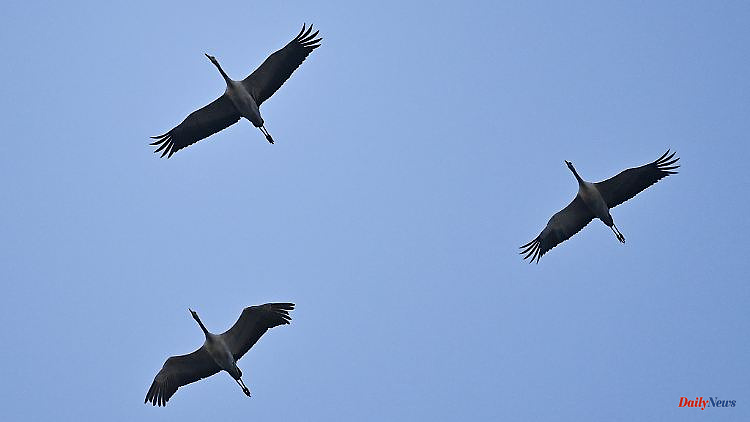Bird migration in Thuringia began in autumn. Swallows, starlings and songbirds are gone, thousands of birds from more northern latitudes will be stopping in Thuringia in the coming weeks.
Jena (dpa/th) - Soon they will be heard again, the calls of the cranes over the large rest areas in Thuringia: "We expect the first advance guard in the next few days," said the bird expert Tino Sauer from the Thuringian Nature Conservation Union (Nabu ) on request. In particular, the Straußfurt retention basin (Sömma district) and the Kelbra reservoir on the state border with Saxony-Anhalt are large resting places for cranes on their way to warmer regions.
It is possible that the first cranes could already be secured on October 8th at a bird watching organized by Nabu in Straussfurt. "But that depends on the weather," says Sause.
In the period from mid-October to December, several thousand cranes could be sighted every day at the retention basin north of Erfurt. The water is drained in time for the large birds to rest. There alone up to 25,000 cranes have been observed in individual nights. In Kelbra it could be 60,000 to 80,000. Cranes were among the most conspicuous species migrating. Gray geese and russet Egyptian geese have already arrived in Thuringia from northern regions.
On the other hand, summer guests flew away like the starlings. Young birds in particular come to Thuringia in midsummer from Scandinavia and the Baltic States. Most of the swallows left Thuringia on the last weekend in September, "accelerated by the cold air currents". Some swallows even dared to have a third brood in the dry summer thanks to a relatively good supply of insects.
Overall, however, the stock of swallows in Thuringia is declining. "They have a hard time building nests." In some villages, there used to be a swallow's nest in every second house, but today it's perhaps in every 20th house, Sauer said. The decline in numbers is about 2 percent per year. "Over a period of ten years, this is a decrease of one fifth. Unfortunately, this trend is unbroken despite some protective measures."
On the other hand, the stock of white storks in Bavaria shows a positive development. This year there were new nests with breeding pairs in the Gera-Unstrut-Aue, among other places. In the Gotha district alone, 14 breeding pairs were counted. "There used to be maybe three or four there," says the bird expert.
There is also a trend that classic migratory birds try to spend the winter in Thuringia and Germany. In addition to storks, this also includes blackbirds, which used to fly to Africa in winter. In the meantime, blackbirds can often be observed in gardens and parks in winter - if they can find enough food.












